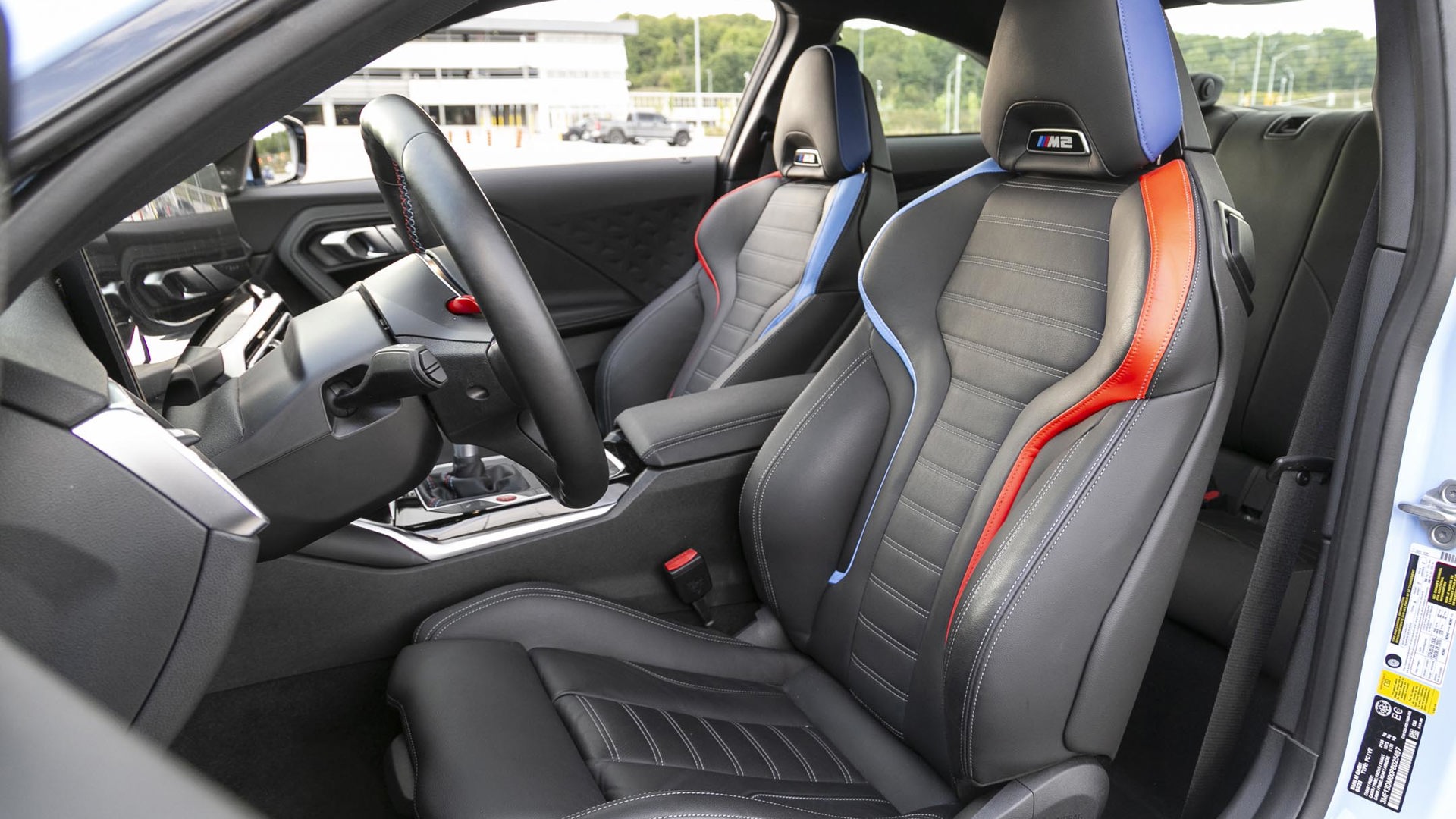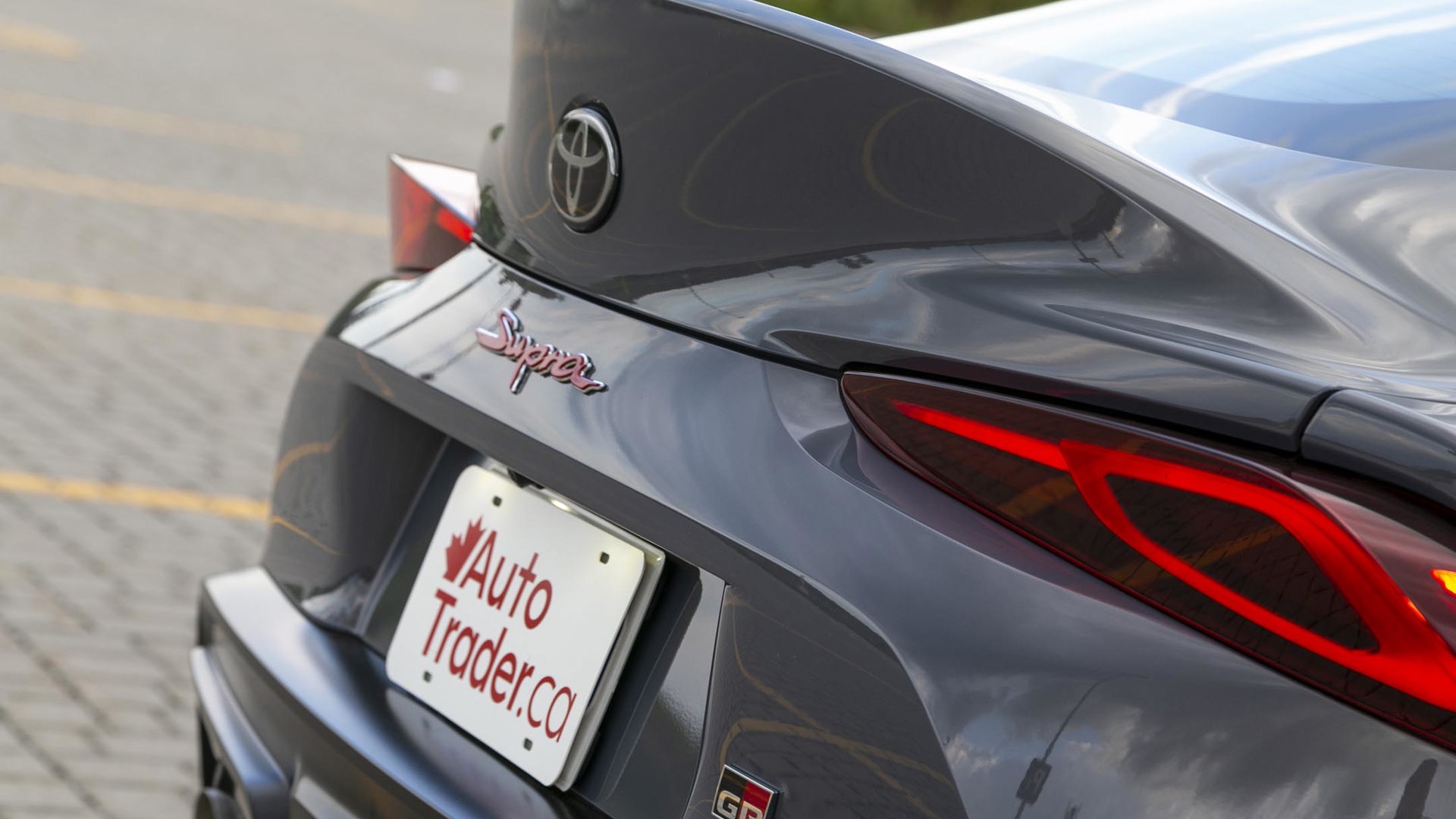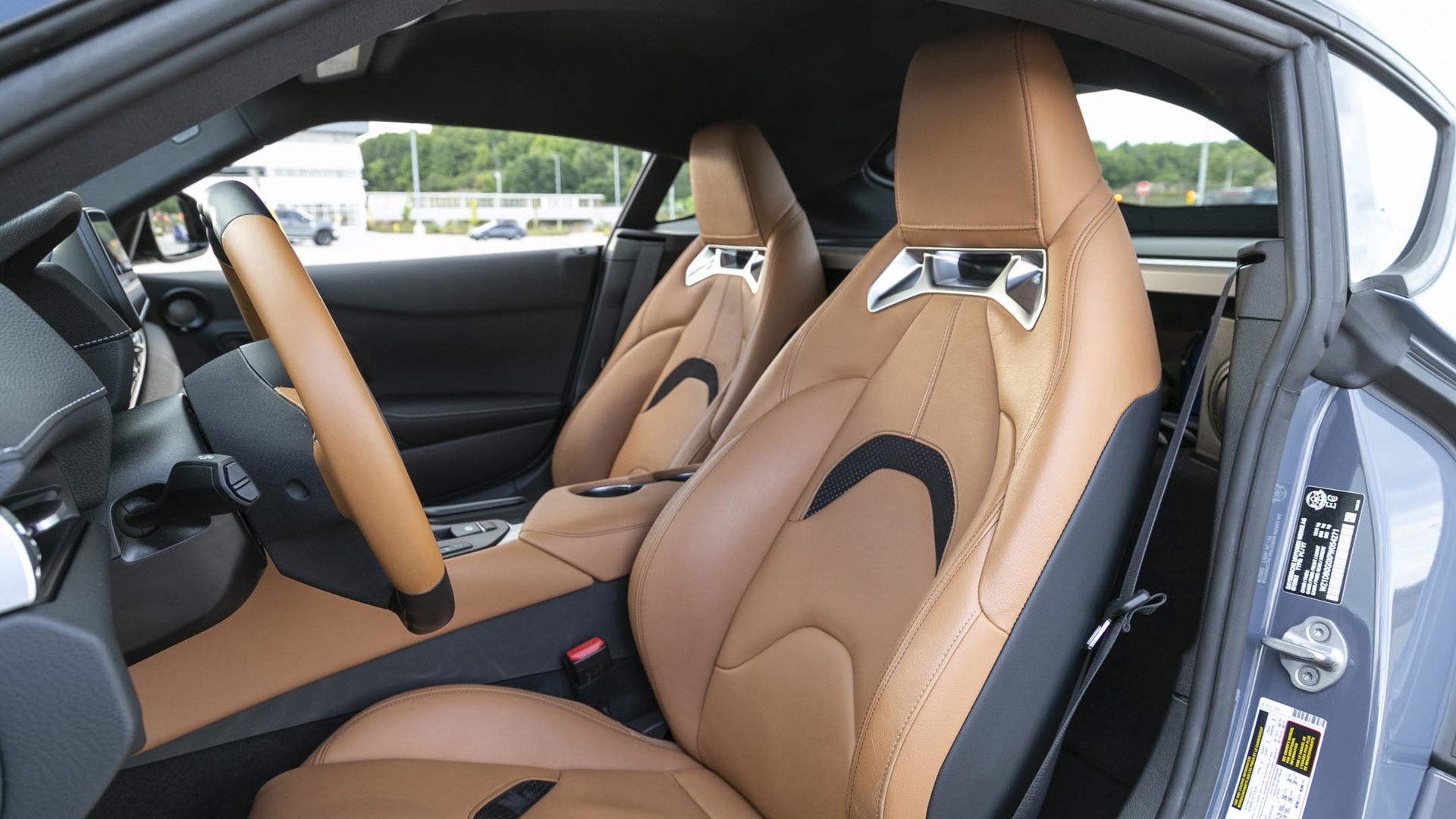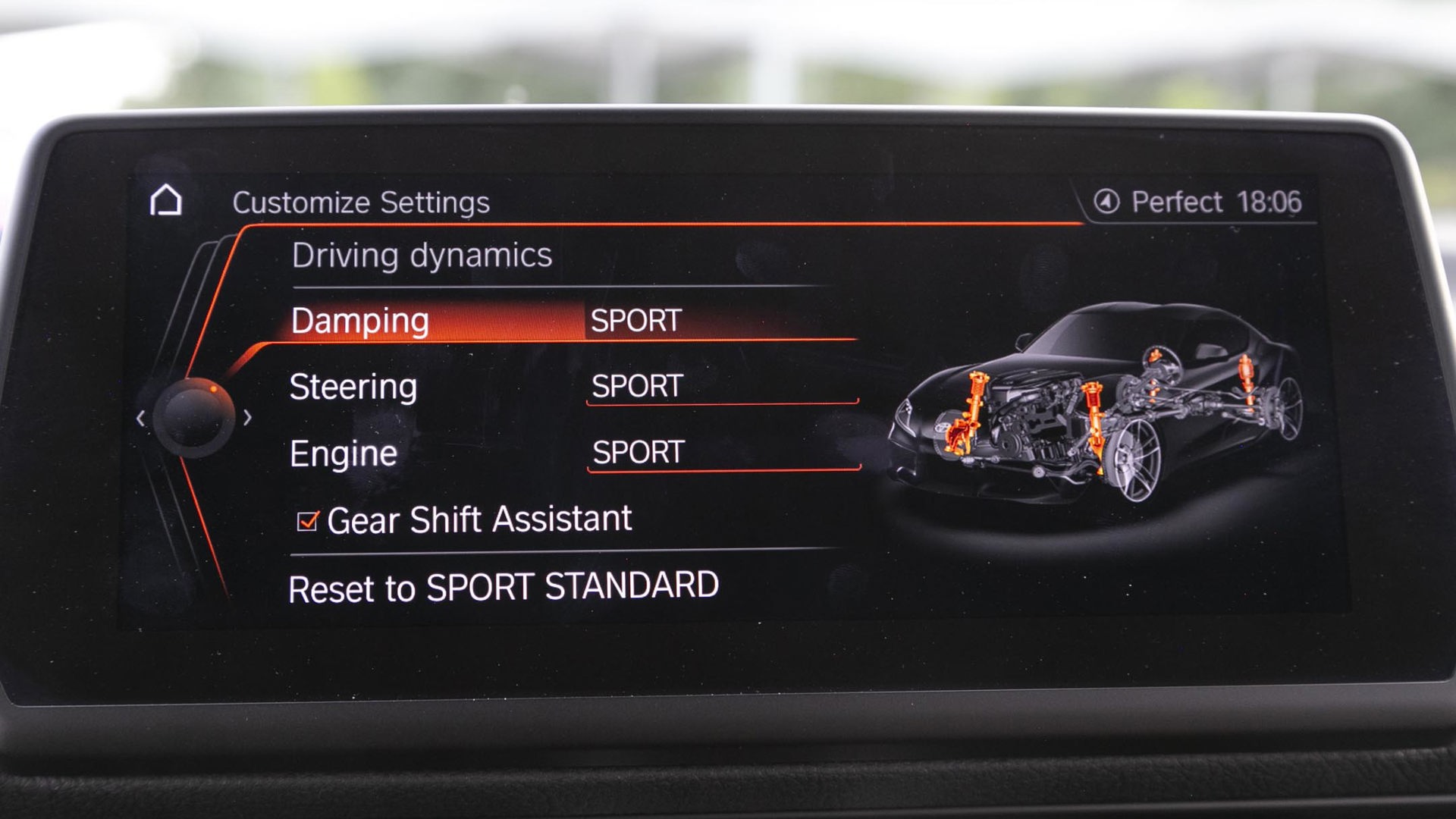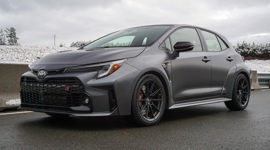Comparison Data
|
2023 BMW M2
|
2023 Toyota GR Supra 3.0T MT
|
|---|---|
|
Engine Displacement
3.0L
|
3.0L
|
|
Engine Cylinders
Twin turbo I6
|
Turbo I6
|
|
Peak Horsepower
453 hp @ 6,250 rpm
|
382 hp @ 5,800 rpm
|
|
Peak Torque
406 lb-ft @ 2,650 rpm
|
368 lb-ft @ 1,800 rpm
|
|
Fuel Economy
14.3 / 10.0 / 12.4 L/100 km cty/hwy/cmb
|
12.7 / 8.8 / 10.9 L/100 km cty/hwy/cmb
|
|
Cargo Space
390 L
|
289 L
|
|
Base Price
$76,500
|
$69,000
|
|
A/C Tax
$100
|
$100
|
|
Destination Fee
$2,480
|
$1,860
|
|
Price as Tested
$82,180
|
$72,590
|
|
Optional Equipment
$3,100 – Premium Package, $3,100
|
$1,630 – 3.0 Premium Manual / A91-MT Edition package, $1,630
|
The number of new cars for driving enthusiasts with a stick shift dwindles yearly, so we thought it time to celebrate two manufacturers still giving drivers what they want – powerful, rear-wheel-drive coupes with proper row-your-own gearboxes.
As if a weird overcompensation for all the beige Camry jokes car enthusiasts have made in recent decades, Toyota has proven lately that it not only has a strong pulse but that there’s still lightning in its veins. The GR86 is one of the best performance car bargains out there, while the new GR Corolla turns everyone behind the wheel into rally stars.
The Supra is the company’s flagship sports machine, but it has suffered some truly unwarranted grief from the internet armchair experts who bemoaned its BMW mechanicals. But those who have actually driven it know that it is one of the best, most engaging new sports cars available today, with a lusty inline six-cylinder engine (just like every Supra before), and wildly amusing, tail-happy handling. And this year, as AutoTrader’s Road Test Editor Dan Ilika pointed out, Toyota has made it better by offering the Supra with a six-speed manual transmission.
BMW is expected to have engaging machinery in the lineup – especially from its performance M division. This is the company that boasted The Ultimate Driving Machine tagline for many years, after all. The M240i astonished with its delicious engine (the same one found under the Supra’s hood) and adept handling, so when BMW announced the M2 with significantly more power and an available stick-shift, we couldn’t wait to try it. Better still, we couldn't wait to pit it against the Supra.
Power
The heart of each of these cars is a smooth, sonorous inline-six. This BMW engine has shown up in various states of tune in everything from small roadsters, to coupes, sedans, wagons, and even SUVs. It’s also beneath the Toyota Supra’s hood, and it’s a sensational mill, delivering linear horsepower and gobs of torque across a prairie-flat powerband. In the Supra, it puts out a claimed 382 hp and 368 lb-ft of torque, but it’s been proven that those figures are rather underrated. With every snarling rip to redline, drivers are treated to a strong and exciting thrust forward (or sideways with the traction control disabled) and affirmation that Toyota’s decision to partner with BMW in building the Supra alongside the BMW Z4 was a wise one.
The M2 gets a true M engine, evolved from the same one in the Supra but with stronger, forged pistons, lower compression rate, higher red line, and most notably, twin turbos compared to the single turbo setup. While also found in the M3 and M4 (plus X3 M and X4 M), the engine is in its least powerful state of tune in the M2, putting out “only” 453 hp and 406 lb-ft of torque. Even though it develops its peak power with more revs, the M2’s engine is still wonderfully tractable and just as happy commuting as it is screaming around a track or favourite secluded back roads.
But those presuming the M2’s extra power will make it run away from the Supra haven’t considered the extra 200 kg (more than 400 lb) of mass it carries over the Toyota. It’s enough bulk to erase the power advantage, and on the road, neither car feels quicker than the other. Car and Driver has confirmed it with identical 3.9-second zero-to-96-km/h runs for each car. Expectedly, the automatic versions of both machines are quicker still.
BMW M2: 9.5/10; Toyota Supra: 9/10
Fuel Economy
A happy benefit of the engine in the Supra is its relative efficiency. Considering its prodigious power, its ability to deliver an easy 8.8 L/100 km on the highway (10.9 combined) is impressive. The M2’s engine is thirstier, consuming 10 L/100 km on the highway (12.4 combined), and since both cars have the same 52-L fuel tanks, the Bimmer’s range is disappointingly short when driven with any sort of enthusiasm. Both cars consume premium fuel.
BMW M2: 6/10; Toyota Supra: 7.5/10
Driving Feel
Despite the objectively similar power-to-weight measures, the way these two cars drive and how they feel could not be more distinctive. With its short wheelbase and Toyota’s suspension tune, the low-slung Supra is a surprisingly wild beast, ready to swing its tail wide at the slightest provocation. Recognizing that this may prove problematic for drivers with more bravado than skill, it does make for an exciting drive experience in an old-school sports car kind of way. When left on, the traction and stability controls can help keep things in check, but for those with a hunger for donuts, the Supra is ready to fry up its rear tires at the push of a button.
The Supra’s steering is quick and sharp, and although the ride is firm, it’s not punishing. The brakes are excellent for on-road use with great feel, immediate bite and strong stopping power, but there are reports that for optimal track use, the Toyota could use more serious brake pads and fluid at a minimum.
There are no such reports for the M2, which appears born ready for hot lapping. Our test was road-based, however, and whether on the highway or being flogged around backroad curves, the BMW was the picture of stability. Its suspension is also stiff, but like the Supra’s, does a good job of filtering out the worst of the road’s imperfections.
The M2’s steering isn’t as quick, nor does it feel as responsive and razor-sharp on-centre as the Supra’s, and it’s lacking road feel. At high speeds, it means the M2 isn’t as darty, which lends to greater stability for those presumed track sessions, but it’s simply not as much fun as the Supra.
In fact, beyond the less engaging steering, the M2’s shifter also isn’t as good as the Supra’s, and even the piped-in sounds aren’t very endearing compared to the wail emitted from the Toyota. The M2 feels like a very well-engineered track tool, while the Supra seems to exist for the sheer joy of driving.
BMW M2: 7/10; Toyota Supra: 9/10
User Friendliness
While both coupes, the BMW’s 2+2 format is built on a platform that’s stretched and shared across multiple models, whereas the Supra’s underpinnings were created specifically as a small, two-seat sports car. This gives the M2 a more upright driving position and appreciably better outward visibility than the Supra with its curved roof that’s sure to send tall drivers and claustrophobics into fits.
For those who fit (like yours truly), the Supra’s cockpit offers a seating position that places the wheel, pedals and shifter exactly where they’re wanted and simply feels like a more exciting, sporty car. Better still, Toyota has used the switchgear from last-generation BMWs with actual buttons instead of forcing all the controls into the infotainment screen and haptic panels like in the M2. The Supra has Apple CarPlay, however, does not have Android Auto, and the M2 has both.
BMW M2: 7/10; Toyota Supra: 8/10
Practicality
There’s no arguing the BMW’s greater practicality, though. As the bigger car, it not only has a backseat (albeit a cramped one that seriously lacks headroom), but its 390L trunk (that can further expand by folding the rear seats) is considerably larger than the 289 L under the Toyota’s hatch. The BMW also rides higher, so with a set of winter tires, one could theoretically daily drive the M2 all year round, where the Supra would just become a sexy snow plow.
BMW M2: 7/10; Toyota Supra: 4/10
Comfort
The M2’s seats are very good, and though not as aggressively bolstered as BMW’s optional carbon buckets, are certainly more comfortable. But they’re not as comfy as the Supra’s, which seemed to suit both Editor-in-Chief, Jodi Lai and myself equally well, offering enough support for long-distance travel, and when G-loading in the corners.
As sports-oriented machines, their suspensions are tensed for high-speed stability, yet neither one is punishing, each taking the edge off the nastiness of our Southern Ontario roads, even if though they won’t be mistaken for luxo cruisers.
BMW M2: 7/10; Toyota Supra: 7/10
Features
Similarly, these cars are nicely finished inside but not overly feature-heavy. Heated, leather, power seats are found in both, but there’s no cooling feature. The BMW has a heated steering wheel, while the Supra makes do without. Neither has a sunroof, but both have automatic climate control and powerful 12-speaker sound systems.
Instead of luxury accoutrements, the true features of these cars are meant to benefit the driver. They’ve each got optional head-up displays and meaty leather-wrapped steering wheels, but much of what makes these machines so good is hidden out of sight with adaptive suspensions, high-end mechanical componentry, lusty engines, and slick transmissions. The M2 also has a highly sophisticated performance computer that’ll enable the driver to fine-tune their preferences, plus monitor such crucial data as the length and duration of one’s drifting.
BMW M2: 7/10; Toyota Supra: 6/10
Safety
Being modern sports cars for purists means incorporating a still impressive suite of safety features for both of these cars with robust structures, a wealth of airbags, automated high beams, and active forward collision avoidance functionality. Both cars have lane departure warnings, but only Toyota’s will help actively steer the car back into the lane, and only the Toyota has adaptive cruise control.
BMW M2: 7/10; Toyota Supra: 8/10
Styling
To suggest BMW’s designers have made some bold decisions lately would be a gross understatement. From the buck-toothed grille on the M3 and M4, to the squint-eyed futuristic faces of the iX and 7 Series, to the XM’s, well, unique direction, BMW’s styling has been polarizing. The M2’s squat rear haunches and bold quad tailpipes present a serious sporting nature, calling upon the square-shouldered DTM race cars of the ’80s. Its profile is similarly aggressive, if a bit stubby, and it’s nice to see some of BMW’s traditional design cues present.
Unfortunately, the M2’s face has gaping square corner vents, and the traditional double-kidney grille (mercifully in a wide, horizontal orientation) lacks any framing, making it look like it’s constructed from slick latex. Credit to BMW for the no-cost, show-stopping pale Zandvoort Blue paint that generated plenty of positive feedback during the test week.
If the BMW looks like a sledgehammer (or that it’s been smashed by one), parked next to it, the Supra looks like a Samurai sword. There’s a lot going on with sheet metal swoops and bulges and vents all over the place, but it’s aggressive and is undeniably sporty. Despite being 200 mm shorter than the M2, the Supra appears longer, lower and meaner. The Supra’s also got voluptuous hips and a pert little flipped-up duck-tail, giving this thing the most seductive automotive back end for less than six figures. Such flamboyance deserves a bolder colour than the bland grey of our tester, though.
Our test M2’s interior is a coal mine of black finishes, brightened only by a few flourishes of bright metallic accent trim and the bold red and blue panels on the doors and seats. The giant pair of rectangular screens are contemporary BMW, and while functional, aren’t glamorous. Meanwhile, the Supra’s interior is more traditional BMW fare with its older generation iDrive screen perched atop the dash, and the two-tone black-and-cognac leather finishes look sensational.
BMW M2: 6/10; Toyota Supra: 9/10
Value
At $76,500, the M2 is the most affordable full-on BMW M car in Canada. Our tester had only the $3,100 Premium Package that added some niceties like keyless entry, adaptive LED headlights, head-up display, and the Harman/Kardon sound system, putting its feature count on par with the Supra. The manual transmission is a no-cost option for both of these cars.
At $69,000, the Supra is several grand cheaper, with our tester wearing the A91-MT Edition package for an extra $1,630 that includes a head-up display, embedded navigation, and the 12-speaker JBL audio system. Its pricing actually aligns better with a similarly equipped BMW M240i than the M2.
Within the sports car segment, an optioned-up Nissan Z costs around $10,000 less (while the upcoming Nismo Z will be slightly more). And for those prioritizing performance over all else, perhaps a C8 Corvette starting in the mid-$70s is worth considering, although it can’t be had with a stick-shift.
BMW M2: 7/10; Toyota Supra: 8/10
The Verdict
This is the end of an era for those who love a powerful, rear-drive sports car with a manual transmission. The M2 is BMW’s final row-your-own model, and this could be the last non-electrified Supra we ever see. Both cars provide scintillating performance, but only one of them complements its impressive numbers with a truly engaging driving experience.
Having owned more BMWs in my life than any other marque, I have a fondness for their blend of performance, style, luxury, and enjoyment, but the new M2, while seriously capable, left both Jodi and I wanting more personality and fun from the company’s purest remaining sports machine. With the Supra, Toyota has leveraged some excellent BMW components and tuned it into a sensational sports car that’s as exciting to drive as it is to behold. It’s one that’s also made so much better by its slick-shifting six-speed. It’s a car that not only wins this comparison test, but has secured its place as one of my favourite sports cars available, offering modern performance with the sort of driving passion rarely found these days in modern cars. For rear-drive, stick-shift sport coupes, this is about as good as it gets.













